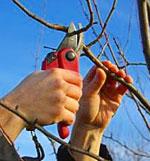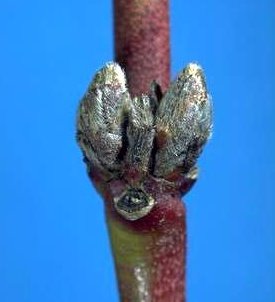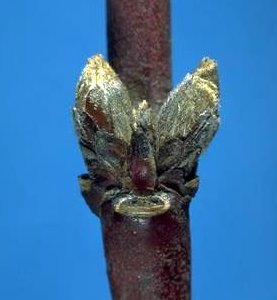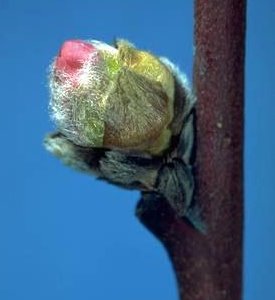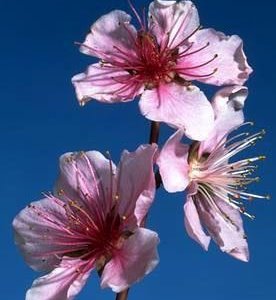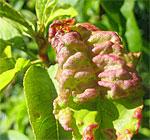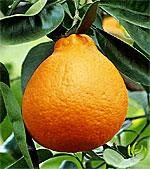
'Mineola' tangelo
|
March
- Harvest spring-ripening orange and mandarin varieties, including tangelo
- Monitor weather to determine if frost protection can be stored until needed in the fall
- Fertilize young fruit trees and citrus trees; half the annual fertilizer dosage is applied this month and the remaining half between May and early August; second dosage for grapefruit and orange is applied in May to prevent thick rinds
- Manage pests: set out codling moth traps by mid-month to monitor when moths are flying (refer to Codling Moth Pest Note, UC ANR Publication 7412).
|
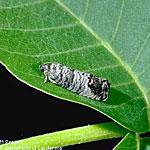
Adult coddling moth
click to enlarge
|
April
- Harvest spring-ripening citrus
- Prune out frost-damaged shoots and limbs from citrus trees.
- Remove sucker growth from base of all fruit trees
- Thin fruit when early-developing fruit is ½ -to 1-inch in diameter, spacing the remaining fruit at least 6 inches apart. Thin clusters of apples and pears to one fruit (see more on fruit thinning)
- To be ready to irrigate fruit trees 2 to 3 weeks after the rains have stopped: test, repair, and flush out the irrigation system, including sprinkler heads and drip emitters. Verify that the irrigation timer is working and set for the amount of water needed
- Manage pests: check fruit weekly for entry holes of codling moth larvae; remove and destroy affected fruit, and spray right away (refer to Codling Moth Pest Note, UC ANR Publication 7412)
|
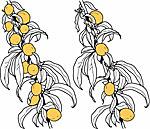
Fruit thinning
click to enlarge
|
May
- Harvest early cherries
- Summer prune later this month, removing new vigorous upright shoots from the tree’s interior and cutting back new shoot growth above the desired tree height (refer to summer pruning (PDF))
- Apply second fertilizer dosage to citrus
- Thin fruit as needed--not usually necessary for cherry, fig, persimmon, and nut trees (refer to fruit thinning)
- Irrigate fruit trees if the season is dry or hot, and apply mulch around trees to conserve water; mulch should not touch tree trunks
- Manage pests:
- Spray when codling moth eggs are estimated to be hatching. (refer to Codling Moth Pest Note, UC ANR Publication 7412)
- Monitor for and prune out fire blight on pears and apples (refer to Fire Blight Pest Note, UC ANR Publication 7414)
|
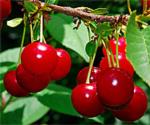
Cherries
|
June
- Harvest cherries, early peaches and pluots
- Prune citrus to shape and lightly thin dense interior branches. Remove citrus water sprouts, suckers, and low hanging branches that could either interfere with sprinklers or allow pests to climb into the trees
- Thin out fruit on mature trees where fruit set is too heavy
- Manage pests:
- If presence of spotted wing drosophila is confirmed in cherry trees, spray two to three weeks before fruit ripens. (refer to Spotted Wing Drosphila Pest Note, UC ANR Publication 74158)
- Spray apples and pears where codling moth larvae damage is seen. (refer to Codling Moth Pest Note, UC ANR Publication 7412)
- Look for and destroy stink bugs
|
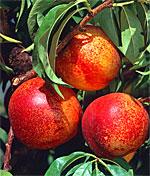
Nectarines
|
July
- Harvest peaches, nectarines, early plums and pluots, and early apples
- Prune apricot and cherry trees after harvest in July or August, and do second summer pruning on deciduous fruit trees after harvest
- Fertilize: after harvest or by early August, apply second dose of fruit tree fertilizer, and water in
- Increase irrigation amount as summer temperatures rise; apply mulch, and don’t allow run off
- Manage pests and disease:
- Remove weeds
- Pick up fallen fruit
|
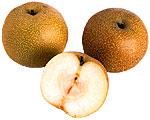
Asian pears
|
August
- Harvest Asian pears and late peaches and nectarines.
- Summer prune for third time, if needed, on very vigorous trees such as plums and pluots
- If not already completed, apply second half of fertilizer dosage to young fruit trees and citrus trees
- Thin heavy fruit set on mandarins, oranges, lemons, and limes
- Manage pests and disease:
- Check apple and pear fruit for damage from third generation codling moth egg hatch, and spray when damage to fruit is seen (refer to Coddling Moth Pest Note, UC ANR Publication 7412).
- Remove and destroy any fallen fruit to reduce new generations of pests.
- Remove weeds
|

Apples
|
September
- Harvest mid-season Fuji and Gala apples, Asian pears, and figs
- Reduce irrigation water as days become shorter and cooler
|
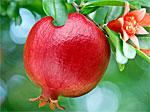
Pomegranate
|
October
- Harvest late apples such as Granny Smith, and pick pomegranates before rains cause cracks in the skin
- Turn off irrigation systems when rains begin
- Manage pests and disease:
- Remove and destroy any fallen fruit to reduce new generations of pests.
- Remove weeds
|
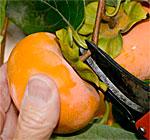
'Fuyu' persimmon
|
November
- Harvest persimmons, pomegranates, early-ripening lemons and limes
- Protect from frost: move potted citrus to sheltered locations, place frost covers nearby to in-ground citrus trees so they can be quickly covered when frosts are predicted (refer to frost protection (PDF) for more information)
- Turn off irrigation systems when rains begin
- Manage pests: monitor for and prune out fire blight on pears and apples (refer to Fire Blight Pest Note, UC ANR Publication 7414)
|
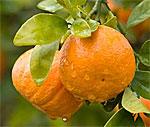
'Satsuma' mandarin
|
December
- Harvest early-ripening mandarins, lemons, and limes
- Continue to monitor for and protect from frost
- Begin winter pruning after most leaves have fallen, and tree structure is visible: remove crowded, crossing, and unwanted branches (See more pruning information (PDF))
- Manage pests: after peach and nectarine trees have dropped leaves, spray to prevent peach leaf curl (refer to Peach Leaf Curl Pest Note, UC ANR Publication 7426)
|
